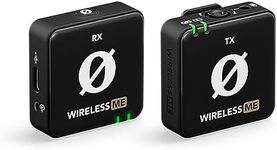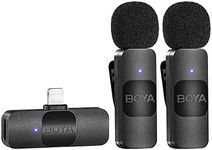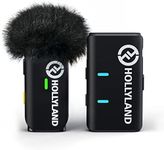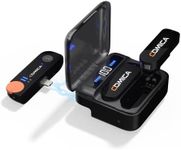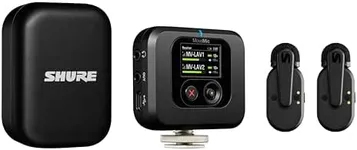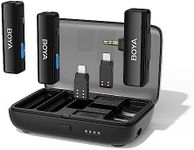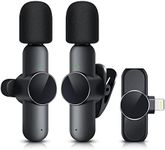Buying Guide for the Best Iphone Microphones
Choosing the right microphone for your iPhone can make a big difference in the quality of your audio recordings, whether you're making videos, recording music, podcasting, or just capturing voice notes. The best microphone for you depends on what you plan to use it for, where you'll be recording, and how much portability you need. Understanding the key features will help you find a microphone that fits your needs and helps you get the best possible sound from your iPhone.Connection TypeThe connection type refers to how the microphone physically connects to your iPhone. The most common options are Lightning, 3.5mm headphone jack, and wireless (Bluetooth). Lightning microphones plug directly into the iPhone's charging port and are often the easiest to use with newer iPhones, which no longer have a headphone jack. 3.5mm microphones require an adapter for most recent iPhones, but can be more versatile if you use other devices. Wireless microphones offer freedom of movement and are great for situations where cables would get in the way, but they may need charging and can sometimes have connection issues. Choose the connection type that matches your iPhone model and your preference for convenience or flexibility.
Microphone TypeMicrophone type describes the design and intended use of the microphone. The main types are lavalier (clip-on), shotgun, handheld, and desktop. Lavalier microphones are small and clip onto your clothing, making them ideal for interviews or presentations. Shotgun microphones are directional and pick up sound from a specific area, which is great for video recording or outdoor use. Handheld microphones are best for interviews or live events, while desktop microphones are designed for stationary use like podcasting or voiceovers. Think about how and where you'll be recording to decide which type suits your needs best.
Polar PatternThe polar pattern describes how a microphone picks up sound from different directions. The most common patterns are omnidirectional (captures sound equally from all directions), cardioid (focuses on sound from the front and reduces noise from the sides and back), and bidirectional (captures sound from the front and back, but not the sides). Omnidirectional microphones are good for group discussions or capturing ambient sound, while cardioid microphones are better for isolating a single voice or sound source. Bidirectional microphones are useful for interviews with two people facing each other. Choose a polar pattern based on the environment and the number of people you want to record.
PortabilityPortability refers to how easy it is to carry and use the microphone on the go. Smaller microphones like lavaliers or compact shotgun mics are easy to carry and set up, making them great for travel, vlogging, or spontaneous recording. Larger microphones, such as desktop or studio mics, offer higher quality but are less convenient to transport. If you plan to record in different locations or need something you can always have with you, prioritize portability.
Power SourceSome microphones draw power directly from your iPhone, while others have built-in batteries or require external power. Microphones that use your iPhone's power are usually more convenient but may drain your phone's battery faster. Battery-powered or rechargeable microphones can run independently, which is useful for longer recording sessions or when you want to avoid using your phone's battery. Consider how long you typically record and whether you'll have access to charging options when choosing a microphone.
Audio QualityAudio quality is determined by factors like frequency response, sensitivity, and noise handling. Higher quality microphones capture a wider range of sounds and produce clearer, more natural audio. For casual use, a basic microphone may be enough, but for music, podcasts, or professional video, look for microphones known for clear sound and low background noise. Think about how important sound quality is for your recordings and choose accordingly.
